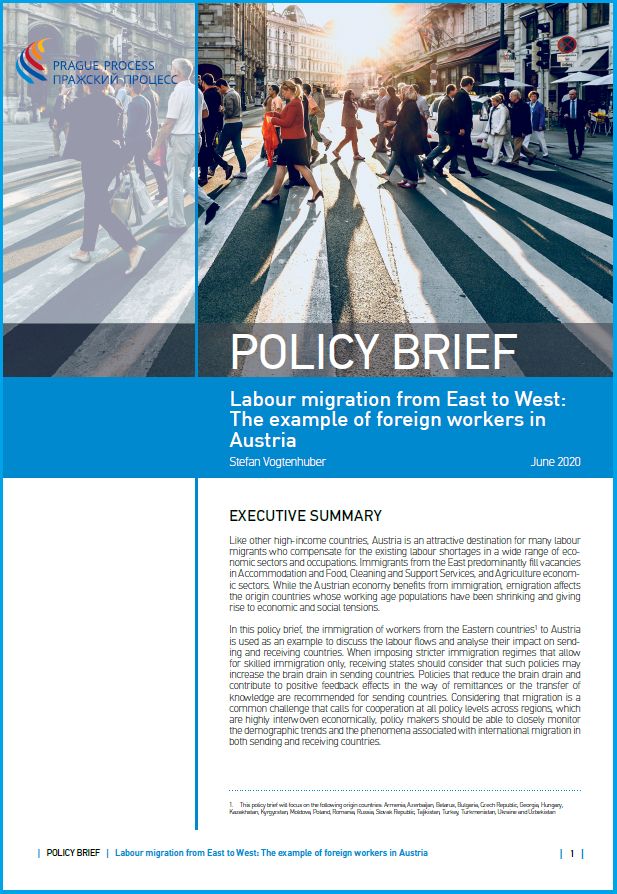Like other high-income countries, Austria is an attractive destination for many labour migrants who compensate for the existing labour shortages in a wide range of economic sectors and occupations. Immigrants from the East predominantly fill vacancies in Accommodation and Food, Cleaning and Support Services, and Agriculture economic sectors. While the Austrian economy benefits from immigration, emigration affects the origin countries whose working-age populations have been shrinking and giving rise to economic and social tensions.
The new policy brief "Labour migration from East to West: The example of foreign workers in Austria" authored by Mr Stefan Vogtenhuber and released by the Prague Process Migration Observatory uses the immigration of workers from the Eastern countries to Austria as an example to discuss the labour flows and analyse their impact on sending and receiving countries.
The brief argues that when imposing stricter immigration regimes that allow for skilled immigration only, receiving states should consider that such policies may increase the brain drain in sending countries. Policies that reduce the brain drain and contribute to positive feedback effects in the way of remittances or the transfer of knowledge are recommended for sending countries. Considering that migration is a common challenge that calls for cooperation at all policy levels across regions, which are highly interwoven economically, policymakers should be able to closely monitor the demographic trends and the phenomena associated with international migration in both sending and receiving countries.
To preview and download the brief please use this link.
Moreover, our Repository
- Policy brief by Haykanush Chobanyan "Armenia's migration cooperation with the European Union and Eurasian Economic Union"
- Policy brief by Rainer Muenz "How will migration to Europe look in the Future? Trends, open questions and four plausible scenarios"
- Policy brief by Ruslan Minich and Pavlo Kravchuk "The Impact of COVID-19 on Ukrainian Labour Migrants in Czechia, Hungary, Poland and Italy"
- Policy brief by Glen Hodgson "Intra-corporate Transferees (ICTs): The benefits for the EU and the opportunity cost"
- Policy brief by Kristof Tamas "Making the EU’s Migration and Development Policies More Coherent"
- Policy brief by Andriy Orlean "Countering Human Trafficking: Identifying, Returning and Assisting Victims from Ukraine"
- Policy brief by Olga Gulina "Russian nationals looking for refuge in the European Union"
- Policy brief by Dmitry Poletaev "Russia’s Migration Policies after the dissolution of the Federal Migration Service"
- Policy Brief by Yan Matusevich "The EU Central Asia Strategy and Its Impact on Migration"
- Policy brief by Kristof Tamas "Assessing the EU's External Migration Policy"
- Training Manual "How to be a good trainer?"
- Policy Brief by Nermin Oruc and Danica Santic "Highly-skilled Return Migrants to the Western Balkans: Should we count (on) them?"
- Analytical Report by Yelena Sadovskaya "China's "Belt and Road" Initiative and Its Impact on Migration Flows and Policies in Central Asia"
- Policy Brief by Petros Aghababyan "Closing the policy gaps concerning an eventual mass influx of asylum seekers to Armenia"
- Policy Brief by Yan Matusevich "Evaluating the Future of Uzbek Labour Migration"
- Analytical Report by Ivanka Heinzl "Report on the National Action Plan to Fight Trafficking in Human Beings of the Republic of Azerbaijan"
- Policy Brief by Haykanush Chobanyan "Assessing Armenia’s Migration Strategy for 2017-2021"
- Policy Brief by Natia Mestvirishvili "Circular Migration Schemes in Georgia"
- Policy Brief by Katerina Ivashchenko-Stadnik "Ukraine: First visa-free year since introducing the visa-free regime"

